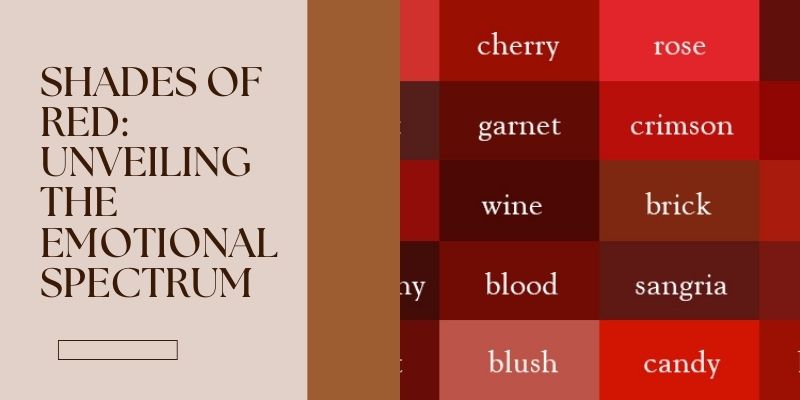Red, a color that stirs the soul, carries with it a myriad of emotions and meanings. From the depths of passion to the peaks of danger, the shades of red offer an intriguing palette for artists, designers, and everyday enthusiasts alike. This article delves into the fascinating world of red, exploring its cultural significance, psychological impact, usage in various fields, and the diverse spectrum of its shades. Whether you’re a connoisseur of color or simply curious, this guide will provide you with valuable insights into the versatile and powerful color red.
The Symbolic Power of Red in Different Cultures
Throughout history, red has been a powerful symbol in various cultures, carrying meanings that range from love to war. Its bold and vibrant nature has made it a key color in ceremonies, rituals, and daily life.
- Passion and Romance: In Western cultures, red is often seen as the color of love and romance. It is the color of red roses, which are gifted to express deep affection and desire. Valentine’s Day is awash with red, symbolizing the fiery passion between lovers.
- Luck and Celebration: In many Asian cultures, red is a symbol of luck, prosperity, and happiness. During Chinese New Year, red is ubiquitous, from lanterns to envelopes filled with money, all intended to bring good fortune and ward off evil spirits.
- Courage and Power: Historically, red has been a color of courage and power. In ancient Rome, red was worn by soldiers and generals as a sign of strength and valor. Today, red continues to symbolize authority and leadership in various contexts.
- Danger and Warning: Red’s high visibility makes it a universal color for danger and warning. From stop signs and traffic lights to warning labels, red effectively grabs attention and signifies caution.
Major Psychological Impacts of Red
Red is not just a visual treat; it also has profound psychological effects on human behavior and emotions. Understanding these effects can help in effectively using the color in various settings.
- Energy and Excitement: Red is an energetic color that can elevate adrenaline levels and stimulate excitement. It’s often used in sports environments and branding to convey dynamism and action.
- Increased Appetite: The color red has been shown to increase appetite, which is why it’s commonly used in restaurant logos, menus, and decor. The next time you find yourself feeling hungry at a fast-food chain, it might just be the red surroundings playing their part.
- Attention and Focus: Red is an attention-grabbing color that can enhance focus and concentration. It’s used in educational settings and advertisements to draw attention and emphasize important information.
- Dominance and Aggression: While red can evoke positive emotions, it can also be associated with dominance and aggression. This makes it a color that commands respect and can sometimes be perceived as intimidating.
The Impact of Red in Art and Design
Red has always been a favorite among artists and designers for its bold and versatile nature. Let’s explore how this vibrant color is used in various creative fields.
- Artistic Expression: Throughout history, red has been a staple in art. Artists like Vincent van Gogh, Henri Matisse, and Mark Rothko have used red to evoke emotion and intensity. Whether it’s the passionate reds of a Matisse painting or the deep, contemplative reds in Rothko’s works, the color has a profound impact on the viewer.
- Interior Design: In interior design, red is used to create warmth, drama, and focal points. Whether it’s a striking red accent wall, a plush red sofa, or red accessories, the color can transform the ambiance of a space. Red is often used in dining rooms and kitchens to stimulate appetite and conversation.
- Fashion: Red is a powerful color in the world of fashion, symbolizing confidence and glamour. From red carpet dresses to bold red accessories, the color makes a statement. Red lipstick remains a timeless choice, exuding elegance and sophistication.
- Branding and Marketing: Many brands utilize red to convey energy and urgency. Companies like Coca-Cola, McDonald’s, and Netflix have successfully incorporated red into their branding, making it an instantly recognizable and memorable color.
Exploring the Shades of Red
The spectrum of red is vast, with each shade carrying its own unique connotations and charm. Here are some fascinating shades of red and what they represent:
- Scarlet: This vivid shade of red with a hint of orange is often associated with passion, energy, and excitement. Scarlet is a color that commands attention and exudes vitality.
- Crimson: A deep, luxurious red with a slight blue undertone, crimson is synonymous with elegance and power. It conveys an air of elegance and high status.
- Burgundy: This dark red with a purplish hue is a symbol of wealth and refinement. Burgundy is often seen as a mature and elegant shade, perfect for creating a sense of luxury.
- Maroon: A dark, brownish-red, maroon is versatile and classic. It represents strength, reliability, and confidence. Maroon is a grounding shade that adds depth to any palette.
- Cherry Red: Bright and cheerful, cherry red brings to mind the vibrant color of ripe cherries. This shade is playful, youthful, and full of life, making it perfect for adding a pop of color.
- Rose Red: Soft and romantic, rose red is gentle and feminine. It symbolizes love, compassion, and tenderness, making it ideal for creating a romantic atmosphere.
- Ruby Red: Inspired by the gemstone, ruby red is rich and opulent. This shade is often linked to passion, desire, and luxury, evoking a sense of grandeur.
- Coral Red: With its warm, pinkish tone, coral red is lively and refreshing. It evokes feelings of joy, warmth, and comfort, perfect for creating a welcoming environment.
The Impact of Red in Digital Media
In the digital age, red continues to play a crucial role in web design, user interfaces, and digital marketing. Here’s how red is effectively used in digital media:
- Call to Action (CTA): Red is a go-to color for call-to-action buttons on websites and apps due to its ability to capture attention and prompt immediate action. Whether it’s a “Buy Now” button or a “Subscribe” link, red encourages user engagement.
- Social Media: Red is a popular choice for social media icons and notifications. Platforms like YouTube and Pinterest use red in their logos, while red notification badges on apps signal new updates or messages.
- Gaming: In the gaming industry, red is often used to indicate danger, urgency, or health status. Health bars, warning signals, and enemy markers frequently utilize red to convey critical information to players.
- Advertising: Digital advertisements leverage the color red to stand out in crowded online spaces. Red banners, pop-ups, and promotional graphics are effective in drawing viewers’ attention and increasing click-through rates.
Conclusion
The shades of red are as diverse as their meanings and applications. From cultural significance to psychological effects, from art and design to digital media, red is a color that continues to captivate and inspire. Understanding the nuances and power of red can enhance your appreciation of this versatile color and its impact on various aspects of life. Whether you’re choosing a shade of red for a creative project, a fashion statement, or a marketing campaign, the world of red offers endless possibilities. Embrace the vibrancy, passion, and depth of red, and let it elevate your expressions and experiences.


